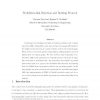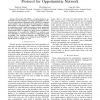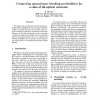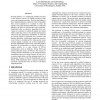CCECE
2009
IEEE
14 years 2 months ago
2009
IEEE
In this paper we investigate the limits of routing according to left- or righthand rule (LHR). Using LHR, a node upon receipt of a message will forward to the neighbour that sits ...
AINA
2010
IEEE
14 years 2 months ago
2010
IEEE
Abstract—We propose PRoPHET+, a routing scheme for opportunistic networks designed to maximize successful data delivery rate and minimize transmission delay. PRoPHET+ computes a ...
WG
1995
Springer
14 years 3 months ago
1995
Springer
Abstract. In this paper, we investigate which processor networks allow klabel Interval Routing Schemes, under the assumption that costs of edges may vary. We show that for each xed...
INFOCOM
1995
IEEE
14 years 3 months ago
1995
IEEE
W e study a class of all-optical networks using wavelength division multiplexing and wavelength routing in which a connection between a pair of nodes in the network is assigned a ...
ICNP
1997
IEEE
14 years 3 months ago
1997
IEEE
Transmission ofmultimedia streams imposesa minimum-bandwidth requirementon the path being usedto ensureend-to-endQuality-ofService (QoS) guarantees. While any shortest-path algori...
FPGA
1995
ACM
14 years 3 months ago
1995
ACM
Routing FPGAs is a challenging problem because of the relative scarcity of routing resources, both wires and connection points. This can lead either to slow implementations caused...
EURODAC
1995
IEEE
14 years 3 months ago
1995
IEEE
Most existing performance-driven and clock routing algorithms can not guarantee performance after all nets are routed. This paper proposes a new post routing approach which can re...
QOFIS
2000
Springer
14 years 3 months ago
2000
Springer
In order to provide various services with different quality requirements, the current Internet is expected to turn into a QoS based Internet under the Differentiated Service (DiffS...
LCN
2000
IEEE
14 years 3 months ago
2000
IEEE
Future computer networks are expected to carry bursty real-time traffic with stringent time-delay requirements. Popular shortest-path routing protocols have the disadvantage of ca...
FPGA
2006
ACM
14 years 3 months ago
2006
ACM
While previous research has shown that FPGAs can efficiently implement many types of computations, their flexibility inherently limits their clock rate. Several research groups ha...




